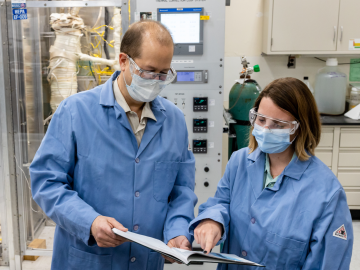
Filter News
Area of Research
- (-) Fusion and Fission (26)
- (-) National Security (33)
- (-) Neutron Science (32)
- Advanced Manufacturing (3)
- Biological Systems (1)
- Biology and Environment (123)
- Biology and Soft Matter (1)
- Computational Biology (2)
- Computational Engineering (2)
- Computer Science (4)
- Electricity and Smart Grid (1)
- Energy Science (78)
- Functional Materials for Energy (1)
- Fusion Energy (15)
- Isotope Development and Production (1)
- Isotopes (28)
- Materials (47)
- Materials for Computing (5)
- Mathematics (1)
- Nuclear Science and Technology (18)
- Quantum information Science (2)
- Supercomputing (109)
News Topics
- (-) Biomedical (17)
- (-) Biotechnology (2)
- (-) Cybersecurity (19)
- (-) Environment (15)
- (-) Fusion (23)
- (-) High-Performance Computing (8)
- (-) Isotopes (1)
- (-) Space Exploration (3)
- (-) Summit (7)
- 3-D Printing/Advanced Manufacturing (11)
- Advanced Reactors (8)
- Artificial Intelligence (19)
- Big Data (8)
- Bioenergy (11)
- Biology (11)
- Buildings (2)
- Chemical Sciences (9)
- Clean Water (2)
- Composites (2)
- Computer Science (32)
- Coronavirus (12)
- Critical Materials (1)
- Education (1)
- Energy Storage (12)
- Exascale Computing (2)
- Fossil Energy (2)
- Frontier (3)
- Grid (8)
- Hydropower (1)
- ITER (6)
- Machine Learning (15)
- Materials (16)
- Materials Science (25)
- Mathematics (1)
- Microscopy (4)
- Nanotechnology (12)
- National Security (35)
- Neutron Science (120)
- Nuclear Energy (33)
- Partnerships (8)
- Physics (11)
- Polymers (1)
- Quantum Computing (1)
- Quantum Science (8)
- Security (13)
- Simulation (4)
- Transportation (9)
Media Contacts

Researchers in the geothermal energy industry are joining forces with fusion experts at ORNL to repurpose gyrotron technology, a tool used in fusion. Gyrotrons produce high-powered microwaves to heat up fusion plasmas.

Though Nell Barber wasn’t sure what her future held after graduating with a bachelor’s degree in psychology, she now uses her interest in human behavior to design systems that leverage machine learning algorithms to identify faces in a crowd.

Practical fusion energy is not just a dream at ORNL. Experts in fusion and material science are working together to develop solutions that will make a fusion pilot plant — and ultimately carbon-free, abundant fusion electricity — possible.

Scientists develop environmental justice lens to identify neighborhoods vulnerable to climate change
A new capability to identify urban neighborhoods, down to the block and building level, that are most vulnerable to climate change could help ensure that mitigation and resilience programs reach the people who need them the most.

ORNL scientists will present new technologies available for licensing during the annual Technology Innovation Showcase. The event is 9 a.m. to 3 p.m. Thursday, June 16, at the Manufacturing Demonstration Facility at ORNL’s Hardin Valley campus.

How an Alvin M. Weinberg Fellow is increasing security for critical infrastructure components

To achieve practical energy from fusion, extreme heat from the fusion system “blanket” component must be extracted safely and efficiently. ORNL fusion experts are exploring how tiny 3D-printed obstacles placed inside the narrow pipes of a custom-made cooling system could be a solution for removing heat from the blanket.

It’s a simple premise: To truly improve the health, safety, and security of human beings, you must first understand where those individuals are.

ORNL researchers used the nation’s fastest supercomputer to map the molecular vibrations of an important but little-studied uranium compound produced during the nuclear fuel cycle for results that could lead to a cleaner, safer world.

A team of researchers has developed a novel, machine learning–based technique to explore and identify relationships among medical concepts using electronic health record data across multiple healthcare providers.


